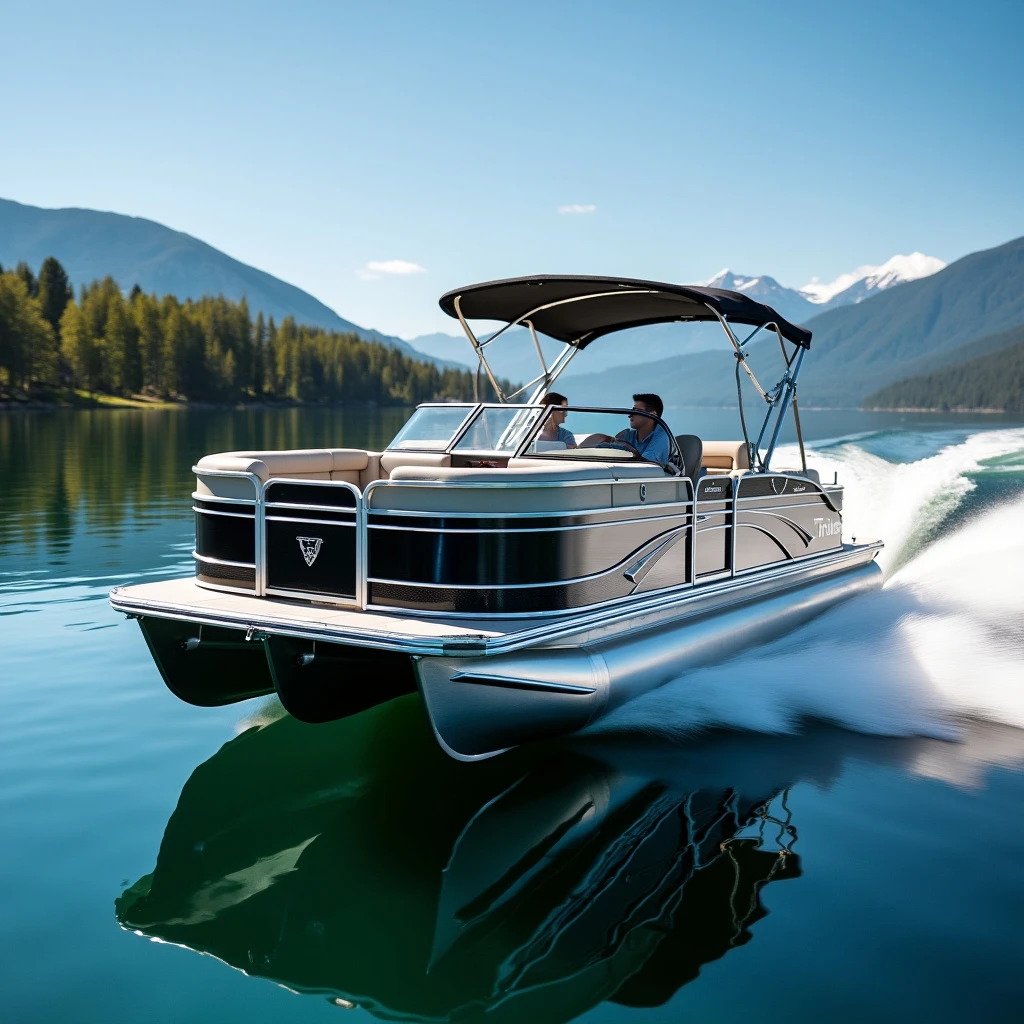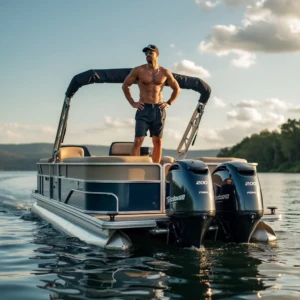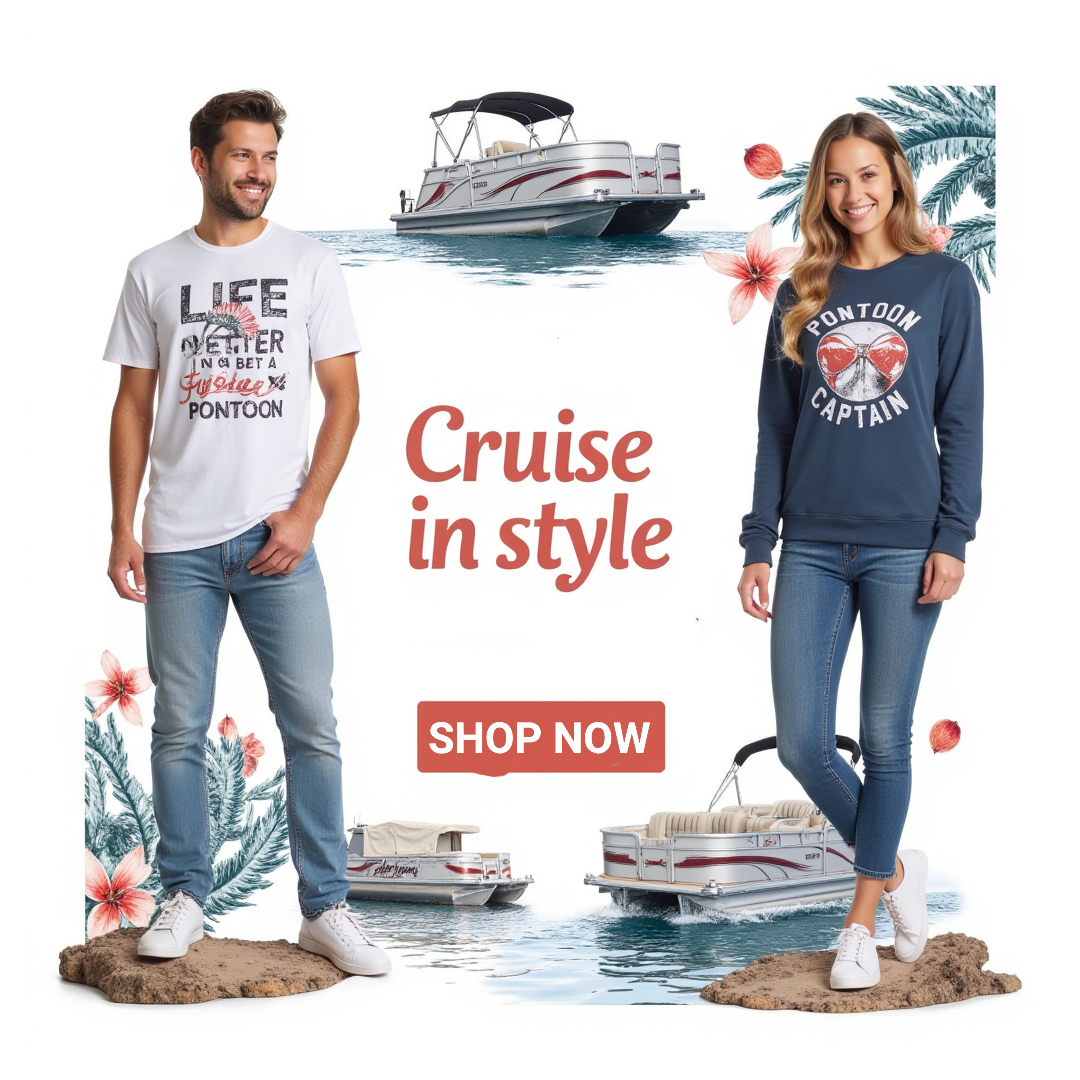Relationship Between Horsepower and Speed on Pontoon Boats
What is a Tritoon?
A tritoon is a type of pontoon boat that has three tubes instead of the standard two. The additional tube provides stability, buoyancy, and improved handling, making it an excellent option for water sports enthusiasts and those who prioritize comfort and luxury on their boating experiences.
Horsepower in Achieving Top Speed
The horsepower of a pontoon boat’s engine is directly proportional to its speed. The more horsepower it has, the faster it can go. When it comes to tritoon boats, having enough horsepower is vital to support the vessel’s increased weight and resistance. With enough horsepower, your tritoon can achieve high speeds for an exhilarating ride across the water.
Comparing Standard Pontoons and Tritoon Performances
Standard pontoons have two tubes, each supporting its weight, while tritoons have three tubes, making them more stable and comfortable. However, tritoons weigh more than standard pontoons, which requires more power to move them through the water. As a result, tritoons can achieve higher speeds compared to standard pontoons.
Factors Influencing Speed: Weight, Design, and Environment
The speed of a tritoon boat is influenced by various factors, such as the boat’s weight, design, and the environment it operates in. Weight management and distribution can affect a boat’s agility, speed, and handling. The design of the hull and tube also plays a significant role in the boat’s performance. Environmental factors, such as water currents and wind speed, can also influence a boat’s speed and performance.
Exploring 200 HP Engines: The Sweet Spot for Performance and Efficiency
Benefits of a 200 HP Engine on a Tritoon
A 200 HP engine is considered the sweet spot for tritoon performance, offering a balance between power and fuel efficiency. One of the major advantages of a 200 HP engine is its ability to propel tritoons to top speeds of 40+ mph with ease, making them perfect for water sports and recreational activities.
Types of 200 HP Engines
When it comes to 200 HP engines for tritoons, there are two options to choose from: two-stroke and four-stroke engines. Two-stroke engines offer higher horsepower to weight ratio, making them lighter and faster. However, four-stroke engines offer better fuel efficiency and lower emissions, making them more eco-friendly and cost-effective in the long run.
Fuel Efficiency and Operating Costs of 200 HP Outboards
Fuel efficiency of a 200 HP engine varies depending on the type of engine and boat design. However, on average, a 200 HP engine consumes around 10-15 gallons per hour at full throttle. Operating costs, including fuel and maintenance, can be expensive, ranging from $200-$600 per month depending on usage and maintenance requirements.
Maintenance Tips to Ensure Optimal Performance
Maintaining a 200 HP engine is crucial for optimal performance and longevity. Some essential tips for maintaining a 200 HP engine on a tritoon include:
- Regularly changing the oil, spark plugs, and fuel filters
- Operating the engine at recommended RPM and throttle speeds
- Flushing the engine after each use to remove saltwater
- Storing the boat and engine in a dry, cool, and ventilated area
iCOVER Outboard Motor Covers, Trailerable Full Boat Motor Cover Waterproof Heavy Duty Oxford Fabric Outboard Engine Covers with Zipper, Fits 100-150HP Motor
The Top Tritoon 200 HP Models on the Market
If you are in the market for a 200 HP tritoon boat, it’s essential to select the best model that suits your needs. This section reviews the leading manufacturers and highlights their top-performing models. Before purchasing any tritoon, it’s essential to consider factors such as speed, comfort, and durability.
Reviewing Leading Manufacturers and Their Models
There are various tritoon manufacturers on the market, and selecting the right model can be overwhelming. In your search, consider high-quality brands such as Bennington, Harris, and Manitou. These brands produce tritoons with high performance, safety features, and comfortability. Bennington’s QX Model is a top-performing tritoon, highly favored for its unique design, luxurious features, and innovative technologies.
Features That Enhance Speed and Stability
Tritoon models with adequate weight distribution, stepped hull design, and premium performance tubes provide enhanced speed and stability. Bennington’s QX30 model features a wave-piercing bow that reduces drag, increasing overall speed. Similarly, Harris’s Crowne SL 270 model boasts of twin 400 HP engines that enhance speed and stability. Ensure to select a tritoon with features that align with your driving conditions, waterworks, and speed preferences.
Customer Reviews and Performance Ratings
Customer reviews provide vital insights into the performance, value, and overall quality of a tritoon model. Most manufacturers display customer reviews on their websites or social media pages. Alternatively, boating communities and forums feature detailed model performance reviews and user experiences. These reviews help in making informed purchase decisions. Ensure to select a tritoon model with high performance ratings and positive customer feedback.
Comparative Analysis: Speed, Comfort, and Durability
Comparative analysis provides insights into different tritoon models’ features, highlighting speed, comfort, and durability. Manitou’s Legacy model, for instance, features high-speed capabilities, luxurious seating, and durable decking. Harris’s Crowne SL 270 model boasts of premium features such as an entertainment center, Bluetooth compatible sound system, and a changing room. Ensure to select a tritoon model that aligns with your performance, comfort, and durability needs.
Modifications and Upgrades to Maximize Your Tritoon’s Speed
If you’re looking to take your tritoon’s speed to the next level, there are several modifications and upgrades you can make. These changes can improve your vessel’s performance, stability, and overall speed. Here are some of the most effective modifications and upgrades to consider:
Propellers: Selecting the Right Pitch and Material
Your tritoon’s propeller plays a vital role in its speed and performance. Choosing the right propeller pitch and material can make a significant difference. A propeller with a higher pitch can increase speed, but it can also cause the engine to work harder, potentially decreasing fuel efficiency. Similarly, a lighter material like aluminum can be more fuel-efficient than a heavier material like stainless steel.
Consult with your dealer or boat mechanic to determine the right propeller for your tritoon based on its weight, size, and horsepower.
Hull Design Modifications for Speed Improvement
The tritoon’s hull design can also affect its speed and performance. One modification to consider is the addition of lifting strakes. These are small, angled fins that run parallel to the boat’s length along the outer edges of the pontoons. They help reduce drag and improve stability, which can lead to faster speeds.
You can also consider upgrading your tritoon’s undershields. Undershields are panels that attach to the bottom of each pontoon and help deflect water while reducing drag. Upgraded undershields can be made of lightweight, durable materials, further improving speed and fuel efficiency.
Additional Accessories to Enhance Performance
There are several additional accessories you can add to your tritoon to improve its performance and speed. For example, a high-performance marine stereo system can reduce the weight of your vessel and add to its aesthetic appeal. A GPS speedometer can provide accurate measurements of your tritoon’s speed, allowing you to monitor your performance and make adjustments as needed.
You might also consider upgrading your tritoon’s steering system. A hydraulic steering system can provide faster, more responsive steering, improving handling and overall performance at high speeds.
Weight Management and Distribution for Peak Speeds
The weight and distribution of your tritoon’s load can also impact its speed and performance. Distribute weight evenly across the boat to avoid excess weight on one side, which can add drag and reduce speed. Avoid overloading your tritoon with excessive gear or passengers, as this can decrease speed and efficiency.
Keep in mind that weight reduction can also improve speed. Removing unnecessary gear or opting for lighter accessories can help reduce the overall weight of your tritoon, leading to faster speeds and better fuel efficiency.
By making these modifications and upgrades, you can maximize your tritoon’s speed and performance on the water. Be sure to consult with a professional before making any significant changes to your vessel.
| Modification or Upgrade | Effect on Tritoon’s Speed/Performance |
|---|---|
| Propellers | Choosing the right pitch and material can increase speed and fuel efficiency |
| Hull Design Modifications | Addition of lifting strakes and upgraded undershields can reduce drag and improve stability, leading to faster speeds |
| Additional Accessories | High-performance marine stereo system and GPS speedometer can improve the vessel’s aesthetics and provide accurate speed measurements |
| Weight Management and Distribution | Even distribution of weight and weight reduction can increase speed and fuel efficiency |
Safe and Responsible Boating at High Speeds
Boating at high speeds can be exhilarating, but it also comes with risks. Responsible boaters must prioritize safety while enjoying the rush of speed on the water. Follow these tips to protect yourself, your passengers, and other boaters:
Understanding the Safety Implications of High-Speed Boating
Understanding the inherent risks involved in boating at high speeds is critical. High-speed collisions can cause serious injuries or fatalities. In addition, high-speed boating can create dangerous wakes that can cause flooding, capsizing, or other accidents. It’s essential to understand the dangers and take necessary precautions before embarking on a high-speed boating adventure.
Best Practices for Operating Your Tritoon at High Speeds
- Always follow manufacturer operating guidelines and recommendations.
- Check weather and water conditions before departing.
- Ensure the operator is experienced and trained in high-speed boating.
- Always wear appropriate safety gear, including life jackets and helmets.
- Never operate a boat under the influence of alcohol or drugs.
Navigational and Local Regulations to Consider
Navigational and local regulations are put in place to ensure safety on the water. Be sure to review and follow these regulations before embarking on a high-speed boating adventure. Some common regulations include speed limits, no-wake zones, and restrictions on reckless boating behaviors, such as jumping wakes, weaving between boats, and cutting across the path of other boats.
Essential Safety Equipment for Speed Enthusiasts
Safety gear is an essential component of high-speed boating. Some important pieces of safety gear include:
| Personal Floatation Devices (PFDs) | Ensure all passengers are wearing properly-fitted PFDs that meet Coast Guard requirements. |
| Helmets | Boaters operating at high speeds should wear helmets to protect their heads in the event of an accident. |
| Fire Extinguishers | Boats with gasoline engines must carry a Coast Guard-approved fire extinguisher. |
| Signal Devices | Signal devices such as flares and smoke signals can help boaters attract attention in the event of an emergency. |
Frequently Asked Questions
- What is the maximum safe speed for a pontoon boat?
It depends on several factors, including the weight of the boat, the design of the hull, and the water conditions. In general, most pontoon boats can safely operate at speeds of up to 35 mph.
- Do I need a license to operate a pontoon boat at high speeds?
License requirements vary by state. Check with your local licensing agency to determine if a license is required to operate a pontoon boat at high speeds in your area.
- What should I do if I encounter another boater operating recklessly?
If you witness reckless boating behavior, report it to your local boating authority or the Coast Guard immediately. Do not engage with the other boater or attempt to confront them.
- What should I do in the event of an emergency?
If you experience an emergency while operating your pontoon boat at high speeds, remain calm and follow appropriate emergency procedures. Be sure all passengers are wearing PFDs and signal for help using flares or other signal devices.




















